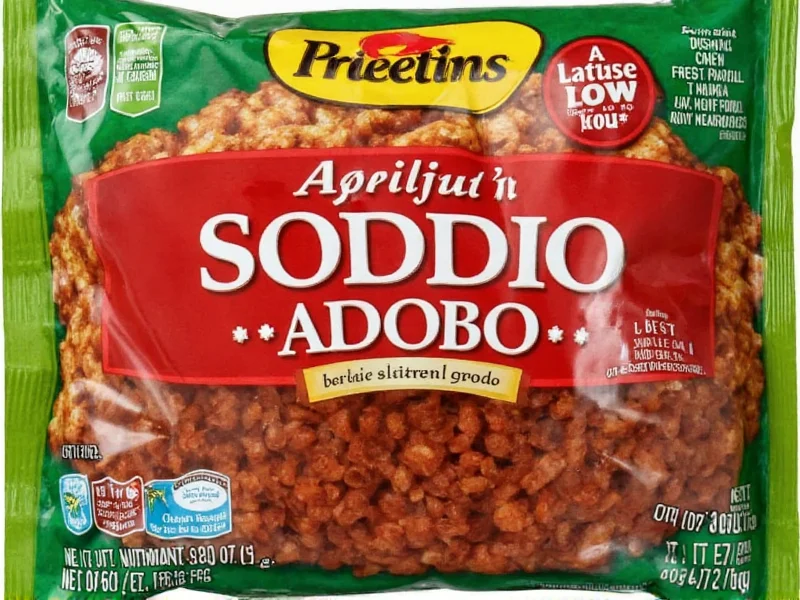Why Traditional Adobo Needs Sodium Reduction
Traditional Filipino adobo typically contains 1,200-1,500mg of sodium per serving—nearly two-thirds of the American Heart Association's recommended daily limit. This high sodium content primarily comes from soy sauce and sometimes added salt. For individuals managing hypertension, kidney disease, or heart conditions, standard adobo poses significant health risks. The good news is that thoughtful ingredient substitutions create a low sodium adobo recipe that maintains complexity while cutting sodium dramatically.
Smart Sodium Reduction Techniques
Creating authentic-tasting healthy Filipino adobo requires understanding flavor chemistry. Sodium isn't just for saltiness—it enhances umami and balances acidity. Our approach focuses on three key strategies:
- Low-sodium soy alternatives: Use reduced-sodium soy sauce (50% less salt) combined with liquid aminos for deeper umami
- Vinegar balancing: Increase vinegar proportion slightly to compensate for reduced saltiness
- Aromatic layering: Double garlic and add bay leaves early for complex flavor development
Perfect Low Sodium Adobo Recipe
This tested heart healthy adobo recipe serves four with just 600mg sodium per serving—50% less than traditional versions while delivering authentic taste.
| Ingredient | Traditional Amount | Low Sodium Substitute | Sodium Reduction |
|---|---|---|---|
| Regular soy sauce | 1 cup | ½ cup low-sodium soy sauce + ½ cup coconut aminos | 65% less sodium |
| Vinegar | ½ cup | ⅔ cup (slight increase) | N/A |
| Salt | 1 tsp | None (omit completely) | 100% reduction |
| Garlic | 6 cloves | 12 cloves (doubled) | Flavor enhancement |
Step-by-Step Cooking Instructions
Follow these precise steps for reduced sodium adobo cooking success:
- Brown proteins properly: Use 2 lbs chicken thighs or pork belly. Pat dry and sear until golden (this builds flavor without added salt)
- Sauté aromatics: Cook 12 garlic cloves and 2 bay leaves in 2 tbsp oil until fragrant but not browned
- Build sauce base: Add ½ cup low-sodium soy sauce, ½ cup coconut aminos, and ⅔ cup cane vinegar. Stir to combine
- Simmer gently: Return proteins to pot with sauce. Add ½ cup water. Cover and simmer 45 minutes (chicken) or 90 minutes (pork)
- Reduce sauce: Uncover and simmer 15 minutes to thicken. Taste and adjust with black pepper (never additional salt)
Nutritional Benefits Comparison
Our low sodium adobo recipe delivers significant health advantages while preserving authentic taste:
| Nutrient | Traditional Adobo | Low Sodium Version | Improvement |
|---|---|---|---|
| Sodium | 1,400mg | 600mg | 57% reduction |
| Protein | 28g | 27g | Maintained |
| Healthy fats | 18g | 17g | Maintained |
| Garlic compounds | Standard | Double | Enhanced benefits |
Pro Tips for Flavor Maximization
Achieve restaurant-quality results with these low sodium adobo cooking techniques:
- Marinate overnight: Let proteins soak in ¼ of the sauce mixture for deeper flavor penetration
- Add citrus zest: Include 1 tbsp calamansi or lemon zest to brighten flavors without salt
- Use homemade stock: Replace water with unsalted chicken or pork stock for richer base
- Finish with fresh herbs: Stir in chopped cilantro or scallions before serving for aromatic lift
Avoiding Common Low Sodium Mistakes
Many home cooks make these errors when attempting healthy Filipino adobo:
- Overcompensating with sugar: Don't add sweeteners to replace salt—focus on umami instead
- Using salted broth: Always verify broth is truly unsalted (many "low sodium" broths still contain significant salt)
- Skipping the sear: Proper browning creates fond that builds flavor complexity without sodium
- Reducing vinegar too much: Maintain proper acid balance to compensate for reduced salt
Serving Suggestions for Complete Meals
Pair your heart healthy adobo recipe with these complementary low-sodium sides:
- Steamed jasmine rice cooked with pandan leaf for subtle fragrance
- Garlic sautéed bitter melon (ampalaya) for contrasting bitterness
- Simple cucumber salad with rice vinegar and black pepper
- Steamed eggplant with ginger and scallions
Frequently Asked Questions
Can I make low sodium adobo without soy sauce?
Yes, you can create soy-free low sodium adobo using ¾ cup coconut aminos combined with ¼ cup fish sauce (reduced sodium version). This provides umami depth while keeping sodium under 700mg per serving. Add 1 tbsp mushroom powder for extra savory notes.
How do I store and reheat low sodium adobo properly?
Store cooled adobo in airtight containers for up to 4 days in the refrigerator or freeze for 3 months. Reheat gently on the stove with 2-3 tbsp water to prevent drying. The flavors actually improve after 24 hours as the proteins absorb the sauce, making it ideal for meal prep.
What's the best low sodium soy sauce alternative for authentic adobo flavor?
For authentic flavor in reduced sodium adobo cooking, combine Kikkoman Less Sodium Soy Sauce with coconut aminos in a 1:1 ratio. This maintains the proper balance of saltiness and umami while cutting sodium by 50%. Bragg's Liquid Aminos alone works but lacks the subtle fermented complexity of soy.
Can I use apple cider vinegar instead of cane vinegar in low sodium adobo?
Yes, but adjust proportions carefully. Use ½ cup apple cider vinegar plus 2 tbsp calamansi or lemon juice to mimic cane vinegar's bright acidity. Avoid distilled white vinegar as it creates harsh flavors. The key is maintaining the 1:1.3 ratio of soy mixture to vinegar for proper low sodium adobo recipe balance.
How can I boost flavor in low sodium adobo without adding salt?
Maximize flavor through technique: double garlic and sauté until golden (not burned), add 1 extra bay leaf, include 1 tbsp black peppercorns, and finish with fresh calamansi zest. Proper protein browning creates fond that builds complexity. These methods enhance healthy Filipino adobo without sodium.











 浙公网安备
33010002000092号
浙公网安备
33010002000092号 浙B2-20120091-4
浙B2-20120091-4